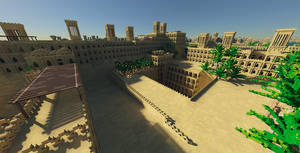Information
- Publication Type: Bachelor Thesis
- Workgroup(s)/Project(s):
- Date: October 2025
- Date (Start): 18. November 2024
- Date (End): 13. October 2025
- Matrikelnummer: 12121278
- First Supervisor: Michael Wimmer

- Second Supervisor: Annalena Ulschmid

- Keywords: Real-Time Rendering, Voxels, Global Illumination, Ray Tracing
Abstract
Achieving realistic real-time rendering of 3D worlds using path tracing remains a significant challenge due to the high sample count required for noise-free images. With voxel-worlds there are some opportunities for optimizations from its unique geometric structure. Typically, real-time applications are constrained to only a few samples per pixel, requiring additional processing to result in a noise-free image. Traditional solutions attempt to address this issue through spatial and temporal reuse of samples or other image data, but implementations frequently introduce undesirable artifacts such as blurring, ghosting, or flickering. In voxel worlds this is especially undesireable because of its sharp geometric features.
In this work, we explore a specialized rendering pipeline for voxel-based worlds. We adapt existing techniques to voxel geometry and use a different approach for temporal reuse in order to minimize image artifacts. We begin by generating a low-sample image using path tracing, which is then refined using temporal and spatial resampling. A simple denoiser optimized for preserving details is then applied to remove most of the noise. As a last step, our specialized approach to Temporal Anti-Aliasing (TAA) is applied, which is a central contribution of our pipeline as it removes almost all common artifacts.
To evaluate our approach, we conduct a series of qualitative and quantitative experiments. Visual comparisons against standard techniques show an improvement in image clarity. Performance benchmarks demonstrate that our pipeline operates within real-time constraints on modern GPUs, validating its practical applicability for interactive voxel-based applications such as video games.
By combining sample refinement adapted to voxel words with lightweight denoising and a data-driven TAA strategy, our method achieves realistic real-time rendering of voxel environments using path tracing with minimal artifacts.
Additional Files and Images
Additional images and videos
Additional files
Weblinks
No further information available.
BibTeX
@bachelorsthesis{ott-rgi,
title = "Real-Time Global Illumination for Voxel Worlds",
author = "Marvin Ott",
year = "2025",
abstract = "Achieving realistic real-time rendering of 3D worlds using
path tracing remains a significant challenge due to the high
sample count required for noise-free images. With
voxel-worlds there are some opportunities for optimizations
from its unique geometric structure. Typically, real-time
applications are constrained to only a few samples per
pixel, requiring additional processing to result in a
noise-free image. Traditional solutions attempt to address
this issue through spatial and temporal reuse of samples or
other image data, but implementations frequently introduce
undesirable artifacts such as blurring, ghosting, or
flickering. In voxel worlds this is especially undesireable
because of its sharp geometric features. In this work, we
explore a specialized rendering pipeline for voxel-based
worlds. We adapt existing techniques to voxel geometry and
use a different approach for temporal reuse in order to
minimize image artifacts. We begin by generating a
low-sample image using path tracing, which is then refined
using temporal and spatial resampling. A simple denoiser
optimized for preserving details is then applied to remove
most of the noise. As a last step, our specialized approach
to Temporal Anti-Aliasing (TAA) is applied, which is a
central contribution of our pipeline as it removes almost
all common artifacts. To evaluate our approach, we conduct a
series of qualitative and quantitative experiments. Visual
comparisons against standard techniques show an improvement
in image clarity. Performance benchmarks demonstrate that
our pipeline operates within real-time constraints on modern
GPUs, validating its practical applicability for interactive
voxel-based applications such as video games. By combining
sample refinement adapted to voxel words with lightweight
denoising and a data-driven TAA strategy, our method
achieves realistic real-time rendering of voxel environments
using path tracing with minimal artifacts.",
month = oct,
address = "Favoritenstrasse 9-11/E193-02, A-1040 Vienna, Austria",
school = "Research Unit of Computer Graphics, Institute of Visual
Computing and Human-Centered Technology, Faculty of
Informatics, TU Wien ",
keywords = "Real-Time Rendering, Voxels, Global Illumination, Ray
Tracing",
URL = "https://www.cg.tuwien.ac.at/research/publications/2025/ott-rgi/",
}


